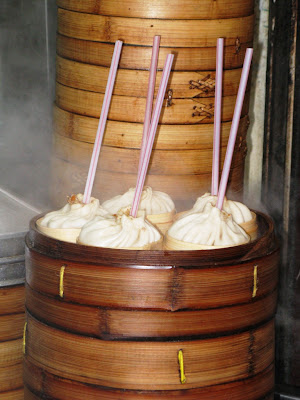

This year there was an arts and crafts festival at the Old Town. Many of the traditional Chinese crafts which included paintings, paper-cuttings, seals, and many other handmade items were being sold at the market. Today we decided to buy a seal. Seals have been used for many years around China. Seals were used to mark ones own possessions as well as contracts and documents. These seals are made of many materials and are hand carved. We purchased our seal for a negotiated price of 30 RMB ($4.38 US). The market is the best place to get local arts and crafts. Always remember to negotiate. Once the price was negotiated, the artist would make the seal with one's name. We chose to have the Chinese version of our name on top with the English name on the bottom half of the seal.

After lunch, we decided to go to Longhua Market. This market sells clothes, watches, jewelry, purses, and so many other things at low prices. There is one catch. The prices actually start a little high. Here you have to use your negotiating skills to reduce the price. A long sleeve polo shirt can be sold from 40 RMB to 100 RMB ($5.83 US to $14.60 US). Your price depends on your negotiating skills and what you are willing to pay. Tourists will usually pay a little more than a local because a local will usually know fair market price. If you come to China, get some local help with the shopping!
After buying some clothes, we were of to the electronics market Mei Luo Cheng. This market works the same way as Longhua except it sells all electronic items from USBs, Cameras, and PCs. It is a huge electronic market with hundreds of stores inside. Here it is critical you know fare market price for the items or you could be spending hundreds of dollars more. We limited our purchases to an all in one card reader and a memory stick for my son's PSP already loaded with games.
We also had dinner at the electronic market. The method for ordering food was pretty electronically automated. First, you would purchase a card for the amount you would like to spend in food. Then you could go to any one of the food court stores and order food. You would present your card to the teller and the money would automatically be deducted from the card. Once your dinner was finished, you could return for the remaining balance on your card or save it for later.
As darkness approached over the city, it would seem as our day in Shanghai was almost over, but in fact it was just another beginning. We wanted to walk the Bund at night. The Bund is the scenic area on the western side of the Huangpu River and claims to be the most scenic spot in Shanghai for both locals and tourists. The west side has many 19th century colonial buildings which served as trading houses and banks earlier in Chinese history. During the night, these buildings light up the area. On the east side across the river the financial area of Pudong lights up the night. There are many ways to view the Bund at night. Boats along the Huangpu river offer tours around the Bund by water. Many people choose the walkway and walk along the river bank taking in the views from both sides of the river.


There are two ways to get to the other side of the river without having to take a taxi to the other side. There is a ferry that goes across the river and there is a pedestrian tunnel that can be used to cross underneath the water. We chose the pedestrian tunnel ,50 RMB ($7.30 US) for round trip, and stopped by the Super Brand Mall for a Starbucks Coffee. We returned to the west side by the pedestrian tunnel and called it a night.




No comments:
Post a Comment